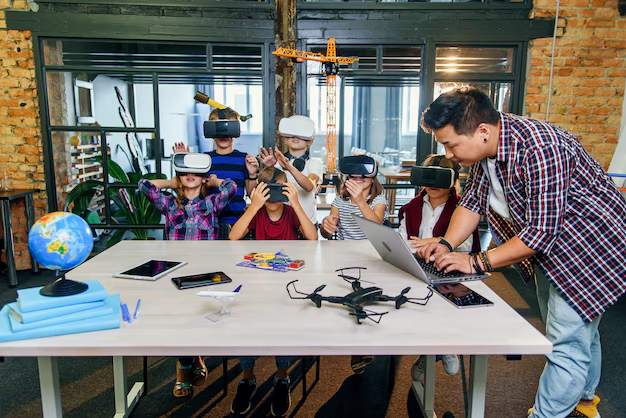The landscape of education is undergoing a dramatic transformation, thanks to technological advancements. Traditional classrooms are evolving, and digital tools are becoming integral to the learning experience. From artificial intelligence (AI) to virtual reality (VR), education is being reshaped to be more accessible, interactive, and personalized. This article explores the future of education and how technology is revolutionizing learning.
The Role of Technology in Modern Education

1. E-Learning and Online Courses
The rise of e-learning platforms has made education more accessible than ever. Students can now enroll in courses from top universities worldwide without leaving their homes. Online platforms such as Coursera, Udemy, and edX offer a variety of courses in different disciplines, making lifelong learning a reality.
2. Artificial Intelligence (AI) in Education
AI-driven learning systems personalize educational experiences by adapting content to the needs of individual students. AI tutors can provide instant feedback and customized study plans, ensuring efficient learning. Additionally, AI chatbots assist students with inquiries, making administrative processes smoother.
3. Virtual and Augmented Reality (VR & AR)
VR and AR technologies create immersive learning experiences. Medical students can practice surgeries in a virtual environment, while history classes can transport students to ancient civilizations. These technologies enhance engagement and make complex subjects more understandable.
4. Gamification in Learning
Gamification integrates game elements into education to boost motivation and engagement. Platforms like Kahoot! and Duolingo use rewards, challenges, and leaderboards to make learning more interactive and enjoyable.
5. Blockchain in Education
Blockchain technology ensures the security and authenticity of academic records. Universities and employers can verify certificates and degrees through a tamper-proof blockchain ledger, reducing fraud and streamlining credential verification.
6. Cloud Computing and Digital Classrooms
Cloud-based platforms allow students and teachers to access learning materials anytime, anywhere. Google Classroom and Microsoft Teams facilitate seamless collaboration and communication, making education more flexible and efficient.
7. Personalized Learning with Big Data
Big Data analytics help educators track student progress and tailor lessons based on individual performance. Data-driven insights enable institutions to identify learning gaps and implement effective teaching strategies.
8. 5G and High-Speed Internet Connectivity
With the expansion of 5G technology, remote learning becomes more efficient and seamless. High-speed internet connectivity ensures smooth video streaming, real-time collaboration, and enhanced accessibility for students in remote areas.
Benefits of Technology in Education

1. Enhanced Accessibility
Technology breaks geographical barriers, allowing students from all over the world to access quality education.
2. Flexibility and Convenience
Online learning enables students to study at their own pace, accommodating different learning styles and schedules.
3. Cost-Effectiveness
Digital resources reduce the need for physical textbooks, making education more affordable.
4. Interactive and Engaging Learning
Technological tools make learning more engaging through multimedia, interactive content, and gamification.
5. Improved Teacher-Student Collaboration
Communication tools and AI-powered assistants facilitate better interaction between students and educators.
Challenges and Considerations

1. Digital Divide
Not all students have equal access to technology, creating a gap in learning opportunities.
2. Privacy and Security Issues
With the rise of digital education, protecting student data and ensuring cybersecurity is crucial.
3. Need for Teacher Training
Educators must be equipped with the necessary skills to effectively use technology in teaching.
4. Over-Reliance on Technology
Balancing traditional teaching methods with technological tools is essential to maintain critical thinking and interpersonal skills.
Also Read : The Role Of Online Learning In Higher Education
Conclusion
The future of education is undeniably digital. Technology is enhancing learning experiences, making education more inclusive and engaging. However, addressing challenges such as accessibility, security, and teacher training is essential for a balanced and effective education system. As we embrace these advancements, a collaborative effort from educators, policymakers, and technology developers will ensure a brighter future for learning.
FAQs
1. What is the role of AI in education?
AI helps personalize learning experiences, provides instant feedback, and automates administrative tasks.
2. How does VR improve education?
VR creates immersive learning environments, allowing students to experience concepts in a more interactive way.
3. What are the benefits of online learning?
Online learning offers flexibility, accessibility, and cost-effectiveness, enabling students to study at their own pace.
4. How can educators adapt to technological advancements?
Educators should receive proper training, use digital tools effectively, and balance technology with traditional teaching methods.
5. What are the challenges of implementing technology in education?
Challenges include the digital divide, data privacy issues, over-reliance on technology, and the need for teacher training.
6. Will traditional classrooms become obsolete?
While digital learning is growing, traditional classrooms will likely evolve rather than disappear, integrating technology with in-person teaching.
7. What role does blockchain play in education?
Blockchain ensures secure and verifiable academic credentials, reducing fraud and streamlining certificate verification.
8. How does gamification enhance learning?
Gamification makes learning fun and interactive by incorporating game elements like rewards, challenges, and leaderboards.
9. What is the future of online degrees?
Online degrees are becoming more accepted and valued, providing flexible and affordable education options.
10. How can technology make education more inclusive?
Assistive technologies, online resources, and AI-driven tools help accommodate students with disabilities and different learning needs.

